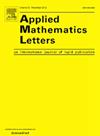带有HIV检测的社区传播模型动力学
IF 2.8
2区 数学
Q1 MATHEMATICS, APPLIED
引用次数: 0
摘要
对社区艾滋病毒感染者进行及时、大规模的检测,有利于早期诊断,有助于从公共卫生和决策者的角度确定艾滋病毒/艾滋病传播的主要趋势。在这项研究中,利用Holling II型功能反应,提出了一个具有HIV检测的SIDMA(易感-感染-诊断-监测-艾滋病)区室模型。考虑到艾滋病毒检测的平均处理时间较慢。我们首先用下一代矩阵法推导了SIDMA模型的基本再现数。然后,在中等条件下,证明了无病平衡点和边界平衡点的全局稳定性。研究结果表明,随着监测速率的增加,整体稳定阈值增大。另一方面,由于HIV检测的平均处理时间足够快,研究结果揭示了通常存在对全局稳定性阈值的低估。本研究发现,通过提高监测率,对社区HIV感染者进行积极的医疗干预,改善了社区HIV感染者的生活质量,也发现社区HIV感染者的流行情况得到了控制。本文章由计算机程序翻译,如有差异,请以英文原文为准。
Dynamics of a community transmission model with HIV detection
The prompt and massive detection of the community population with HIV is beneficial to the early diagnosis and helps to determine the main tendency of HIV/AIDS transmission from the perspective of public health and policy makers. In this study, an SIDMA (Susceptible–Infected–Diagnosed–Monitored–AIDS) compartmental model with HIV detection is proposed by using Holling type II functional response. The slow average handling time in HIV detection is taken into account. We first derive the basic reproduction number of the SIDMA model using the next generation matrix method. Then, the global stabilities for disease-free equilibrium point, and boundary equilibrium point are proved under moderate conditions. The research results show that the threshold of global stabilities increases with the monitoring rate. Alternatively, given that the average handling time of HIV detection is fast enough, the research results explore that the underestimation for the threshold of the global stabilities usually exists. This study reveals that positive medical interventions for the community population with HIV improve the life quality through the enhancement of the monitoring rate, also finds that prevalence situation of the community population with HIV is under control.
求助全文
通过发布文献求助,成功后即可免费获取论文全文。
去求助
来源期刊

Applied Mathematics Letters
数学-应用数学
CiteScore
7.70
自引率
5.40%
发文量
347
审稿时长
10 days
期刊介绍:
The purpose of Applied Mathematics Letters is to provide a means of rapid publication for important but brief applied mathematical papers. The brief descriptions of any work involving a novel application or utilization of mathematics, or a development in the methodology of applied mathematics is a potential contribution for this journal. This journal''s focus is on applied mathematics topics based on differential equations and linear algebra. Priority will be given to submissions that are likely to appeal to a wide audience.
 求助内容:
求助内容: 应助结果提醒方式:
应助结果提醒方式:


